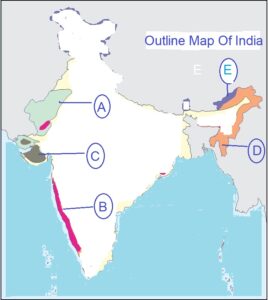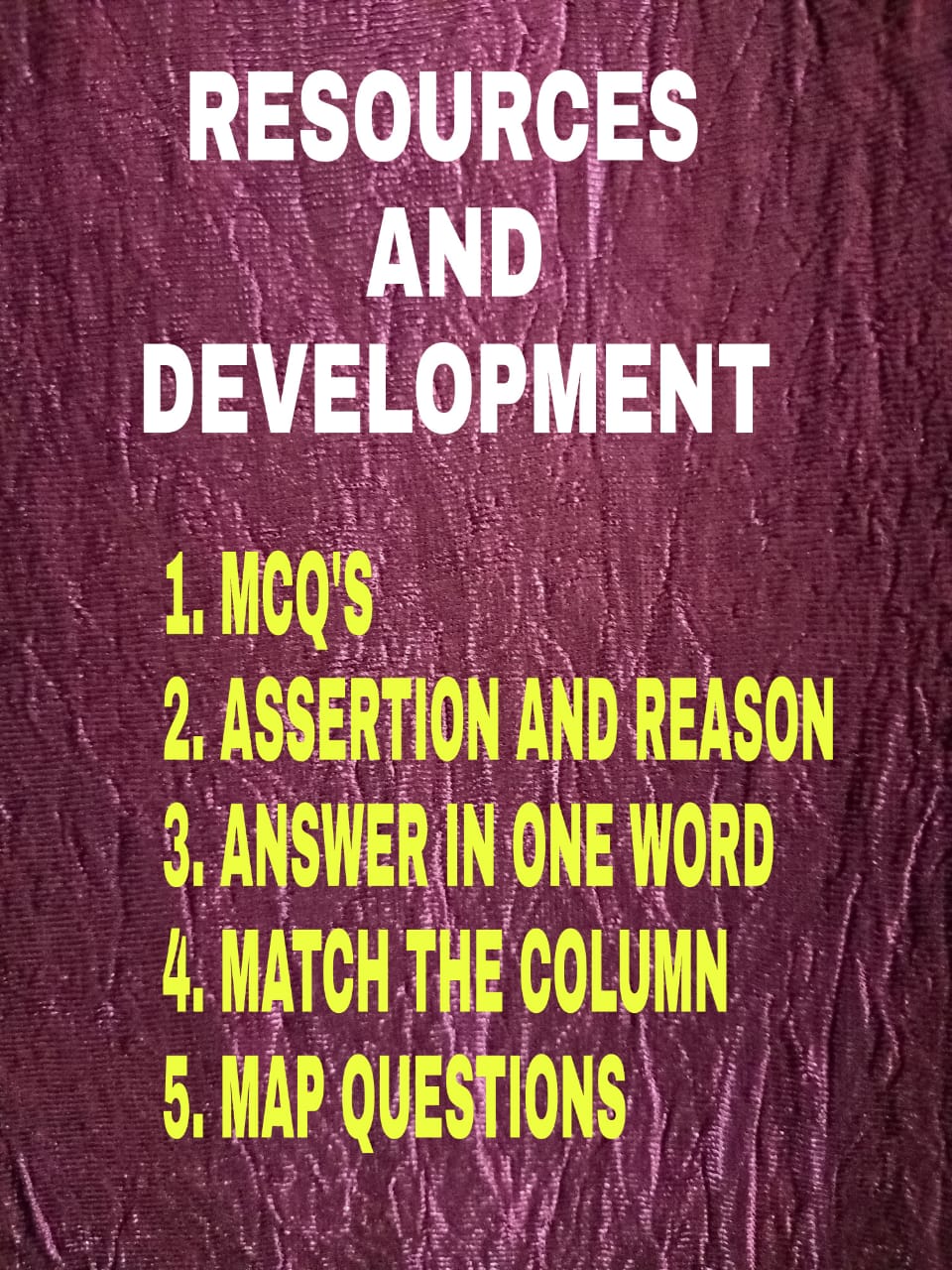Resources and Development at a glance for this year’s class X board students. This year, CBSE has revised the Class X Geography Term-I and Term-II (social science) Syllabus for the current academic session 2022-2023. Board has included all the deleted chapters in the Social Science syllabus. Every student of class X must go through the latest syllabus to know the prescribed topics and paper patterns that will help them prepare for their upcoming CBSE Terminal Exam 2021 in a better manner. For the convenience of all, case study, Assertion, and reason, Fill in the blanks and MCQ-based questions of class X Geography Term-I from Resources and development are provided here for practice. Let’s begin.
Forests and Wildlife Resources – Class X Geography Notes With NCERT Solutions
Class 10 Water Resources worksheet with solution of 24 Questions
Resources and Development Questions as per New Syllabus 2022-23
Multiple Choice Questions (MCQs)
Q1. Which one among the following about the definition of a resource is not correct.
A. technologically accessible,
B. Easily Renewable
C. Economically feasible
D. Culturally acceptable
Solution: B. Easily Renewable is not correct because all resources can not be renewed.
Q2. The process of transformation of things available in our environment involves an interactive
relationship between ____________, technology, and institutions.
A. Physical environment
B. Countries
C. Individuals
D. Economic Development.
Solution: A. Physical environment or Nature is the correct answer because to make any thing useful we need Nature, technology and institutions.
Q3. Which one of the following is an example of a Biotic resource?
A. Soil
B. Sunlight
C. Iron Ore
D. Coal
Solution: D. Coal is the correct answer because biotic resources are not only living things but also things derived from living things.
Q4. The renewable resource may further be divided into ________________?
A. Biotic and Abiotic
B. Continuous or Flow
C. Developed and Potential
D. Stock and reserve.
Solution: B. Continuous or Flow for example growing of forests is a continuous process and air, water, tides are in flow.
Q5.River water can be used for generating hydroelectric power but presently, it is being utilized only to
a limited extent. So, river water in the dam will be ____________ resource?
A. Potential
B. Stock
C. Reserve
D. Non-Renewable
Solution: C. Reserve, because we know the use of water. However, we are not using it intentionally for future use.
Read to Understand
Potential Developed Stock & Reserve With Examples To Avoid Confusion
Q6. Which one of the following statements about sustainable economic development is not correct.
A. development should take place without damaging the environment.
B. development in the present should compromise with the needs of the future generations.
C. development in the present should not compromise with the needs of the future generations.
D. Development should take place without creating any pollution.
Solution: B. development in the present should compromise with the needs of the future generations is not correct.
Q7. One major objective of the Agenda 21 is __________________ .
A. addressing urgent problems of environmental protection and socio- economic development at the global level.
B. Global Climatic Change and Biological Diversity.
C. achieving Sustainable Development in the 21st century.
D. every local government should draw its own local Agenda 21
Forests and Wildlife Resources – Class X Geography Notes With NCERT Solutions
Solution: D. every local government should draw its own local Agenda 21. (A, B, and C was discussed in the earth’s summit but was not the major objective.)
Q8. When was the first International Earth Summit held?
A. 1991
B. 1992
C. 1993
D. 1994
Solution: B. 1992
Q9. First stage of resource planning involves_________________?
A. surveying, mapping and qualitative and quantitative estimation and measurement of the resources.
B. Evolving a planning structure endowed with appropriate technology and skill.
C. Matching the resource development plans with overall national development plan.
D. None of these.
Solution: A. surveying, mapping and qualitative and quantitative estimation and measurement of the resources because (Firstly, identification and inventory of resources across the regions of the country is the first stage. Moreover, this involves surveying, mapping and qualitative and quantitative estimation and measurement of the resources is the first stage of resource planning.)
Q10. Culturable waste land is_______________
A. Barren and waste land
B. Land put to non-agricultural uses,
C. Area sown more than once in an agricultural year
D. land left uncultivated for more than 5 agricultural years.
Solution: D. land left uncultivated for more than 5 agricultural years.
Q11. Which statement related to land data use is not correct?
A. It is available only for 93 per cent of the total geographical area.
B. land use reporting for most of the north-east states except Assam has not been done fully.
C. some areas of Jammu and Kashmir occupied by Pakistan and China have also not been surveyed.
D. land use data of Andaman and Nicobar, Lakshadweep and Thar desert is also not available.
Solution: D. land use data of Andaman and Nicobar, Lakshadweep and Thar desert is also not available. (We have the data of Andaman and Nicobar, Lakshadweep and Thar desert)
Q12. Which Indian state/ Union Territory has net sown area less than 10 %.
A. Andaman and Nicobar islands.
B. Bihar
C. Rajasthan
D. Assam
Solution: A. Andaman and Nicobar islands.
Q13. Which one of the following cannot solve the problem of Land degradation in India?
A. Proper management of waste lands
B. Stabilization of sand dunes.
C. Deforestation.
D. disposal of industrial effluents and wastes after treatment.
Solution: C. Deforestation because, cutting of trees will further increase land degradation.
Q14. On the deltas of which river you will not find Alluvial soil?
A. Godavari
B. Mahanadi
C. Narmada
D. Cauvery
Solution: C. Narmada because this river flows in west direction and do not form delta, rather it forms an estuary. To know more about
DELTA AND ESTUARY, you may click on the given link.
Q15. Black soils are generally poor in __________
A. Calcium Carbonate.
B. Magnesium
C. Phosphoric contents
D. Potash and Lime.
Solution: C. Phosphoric contents
Q16. Red soil looks red because
A. it occurs in a hydrated form.
B. due to diffusion of iron.
C. intense leaching.
D. salt content is very high.
Solution: B. due to diffusion of iron.
Forests and Wildlife Resources – Class X Geography Notes With NCERT Solutions
Forests and Wildlife Resources – Class X Notes With 1,3 & 5 Mark Questions
Resources and Development Questions as per New Syllabus 2022-23
Assertion & Reason-Based Questions
Q17. Assertion: The laterite soil develops under tropical and subtropical climates with the alternate wet and dry season
Reason: Due to the dry climate, and high temperature, evaporation is faster and the soil lacks humus and moisture.
Options:
(A) Both A and R are true and R is the correct explanation of A.
(B) Both A and R are true and R is not the correct explanation of A.
(C) A is true but R is false.
(D) A is false but R is true.
Solution: (C) A is true but R is false because A is about laterite soil and R is about Desert/ arid soil.
Q18. Assertion: the entire northern plains are made of Regur soil. These have been deposited by three important Himalayan river systems– the Indus, the Ganga and the Brahmaputra.
Reason: this soil is very useful for growing tea and coffee.
Options:
(A) Both A and R are true and R is the correct explanation of A.
(B) Both A and R are true and R is not the correct explanation of A.
(C) A is true but R is false.
(D) Both A and R are false.
Solution: (D) Both A and R are false.
Q19. Assertion: Relief, parent rock or bed rock, climate, vegetation and other forms of life and time are important factors in the formation of soil.
Reason: varied relief features, landforms, climatic realms and vegetation types have contributed in the development of various types of soils in India.
Options:
(A) Both A and R are true and R is the correct explanation of A.
(B) Both A and R are true and R is not the correct explanation of A.
(C) A is true but R is false.
(D) A is false but R is true.
Solution: (A) Both A and R are true and R is the correct explanation of A.
Q20. Assertion: The alluvial soil consists of various proportions of sand, silt and clay.
Reason: According to their age alluvial soils can be classified as old alluvial (Bangar) and new alluvial (Khadar)
Options:
(A) Both A and R are true and R is the correct explanation of A.
(B) Both A and R are true and R is not the correct explanation of A.
(C) A is true but R is false.
(D) A is false but R is true.
Solution: A) Both A and R are true and R is the correct explanation of A.
Q21. Assertion: Red and Yellow soil develops on crystalline igneous rocks in areas of low rainfall in the eastern and southern parts of the Deccan plateau.
Reason: It looks Red when it occurs in a hydrated form.
Options:
(A) Both A and R are true and R is the correct explanation of A.
(B) Both A and R are true and R is not the correct explanation of A.
(C) A is true but R is false.
(D) A is false but R is true.
Solution: (C) A is true but B is false because it looks red soil looks yellow in hydrated form.
Q22. Assertion: The black soils are well-known for their capacity to hold moisture. In addition, they are rich in soil nutrients.
Reason: Black soils in Tamil Nadu, Andhra Pradesh and Kerala are more suitable for crops like cashew nut.
Options:
(A) Both A and R are true and R is the correct explanation of A.
(B) Both A and R are true and R is not the correct explanation of A.
(C) A is true but B is false.
(D) A is false but R is true.
Solution: (C) A is true but B is false because Black soil is not found in Tamil Nadu, Andhra Pradesh and Kerala. Moreover, Red laterite soil is suitable for the growth of Cashew nuts.
Q23. Assertion: Forests are considered essential for the maintenance of the ecological balance.
Reason: Forest area in the country is far lower than the desired 33 percent of geographical area.
Options:
(A) Both A and R are true and R is the correct explanation of A.
(B) Both A and R are true and R is not the correct explanation of A.
(C) A is true but B is false.
(D) A is false but R is true.
Solution: (A) Both A and R are true and R is the correct explanation of A.
Q24. Assertion: About 43 per cent of the land area consists of plateau region, which provides facilities for agriculture and industry.
Reason: It ensure perennial flow of some rivers, provide facilities for tourism and ecological aspects.
Options:
(A) Both A and R are true and R is the correct explanation of A.
(B) Both A and R are true and R is not the correct explanation of A.
(C) A is true but R is false.
(D) Both A and R are false.
Solution: (D) Both A and R are false because plateaus cover 27% not 43%. Moreover, plateaus does not ensure perennial rivers.
Q25. Assertion: Net sown area is the area sown in the field but is counted only once in an agricultural year.
Reason: Area sown more than once in an agricultural year plus net sown area is known as gross cropped area.
Options:
(A) Both A and R are true and R is the correct explanation of A.
(B) Both A and R are true and R is not the correct explanation of A.
(C) A is true but R is false.
(D) A is false but R is true.
Solution: (A) Both A and R are true and R is the correct explanation of A.
Sustainable Development Project – Complete Guidance
Class 10 Water Resources worksheet with solution of 24 Questions
Resources and Development Questions as per New Syllabus 2022-23
Answer In One Word Questions
I) Everything available in our environment which can be used to satisfy our needs, provided, it is technologically accessible, economically
feasible and culturally acceptable.
II) Resources obtained from the biosphere and have life such as human beings, flora, and fauna, fisheries, livestock, etc.
III) An example of a community-owned resource.
IV) Resources that are found in a region but have not been utilized.
V) Materials in the environment which have the potential to satisfy human needs but human beings do not have the appropriate technology to access.
VI) India has got the right to mine a resource from the bed of the Indian Ocean which lies beyond the exclusive economic zone.
VII) Development that takes place without damaging the environment and the present should not compromise the needs of future generations.
VIII) Place where the First International Earth Summit was held in 1992.
IX) The running water cuts through the clayey soils and makes deep channels.
X) Strips of grass are left to grow between the crops. This breaks up the force of the wind.
ANSWERS:
I) Resources II) Biotic III) Temple IV) Potential V) Stock VI) Manganese Nodules VII) Sustainable Development VIII) Rio-Di Janeiro.
IX) Gullies X) Strip Cropping.
Resources and Development Questions as per New Syllabus 2022-23
Match the two columns with appropriate answers |
COLUMN A a) Soil texture b) Soil Profile c) land degradation in Punjab d) Land degradation in Gujarat e) India’s territorial water boundary f) Black soil g) laterite soil h) Coal and petroleum | COLUMN B i) overgrazing ii) self-aeration capacity iii) Twelve nautical miles iv) Layers of soil v) Over irrigation vi) Intense leaching vii) Biotic resources. viii) Sandy, clayey, silt |
Resources and Development Questions as per New Syllabus 2022-23
Map-Based Questions:
Features are marked in the given outline map of India. Identify these features with the help of the following information and write their correct names.

CLASS X GEOGRAPHY MAP QUESTIONS
A. These soils range from red to brown in color. They are generally sandy in texture and saline in nature. Arid soil.
B. The soil develops under tropical and subtropical climates with the alternate wet and dry seasons in heavy rainfall areas. Laterite Soil.
C. They are well-known for their capacity to hold moisture. They develop deep cracks during hot weather, which helps in the proper aeration of the soil. Black Soil.
D. This soil develops on crystalline igneous rocks in areas of low rainfall in the eastern and southern parts of the Deccan plateau. Red Soil.
E. These soils are found in hilly and mountainous areas where sufficient water is available. Montane and forest soil.
Forests and Wildlife Resources – Class X Geography Notes With NCERT Solutions
Forests and Wildlife Resources – Class X Notes With 1,3 & 5 Mark Questions
Resources and Development Questions as per New Syllabus 2022-23
Conclusion:
The above-mentioned questions from Resources and Development is to get an idea about the type of questions that can be asked in the examination. Resources and Development is an important and vast chapter. Many questions can easily be framed from this chapter.
The questions given here are simple but tricky. You need to have in-depth knowledge and understanding. Unique questions have been included from Resources and Development. For the latest syllabus updates on social science, click on the given link.
Hope these Geography questions from chapter 1 Resources and Development will help you in scoring better marks in class X.
Kindly share it with your students, friends, and other needy ones.
All the Best.
60 Most Expected Geography Questions In Term I From Class X
7 Geography questions from Resources and Development which can trouble class X students
Class X Resources & Development – How To Write Perfect Answers In Points
Sustainable Development Project – Complete Guidance





0 Comments